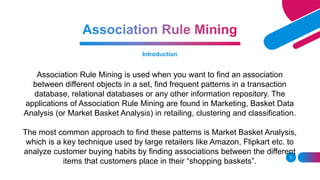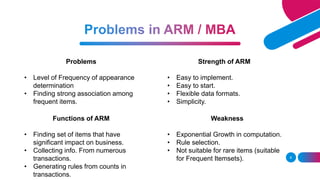Market Basket Analysis
- 1. By Narayan Vyas Submitted To ĻC Dr. Vishal Dutt Dept. of Computer Science, MDSU, Ajmer
- 2. What is Market Basket Analysis? 2 Market Basket Analysis is one of the key techniques used by large retailers to uncover associations between items. It works by looking for combinations of items that occur together frequently in transactions. To put it another way, it allows retailers to identify relationships between the items that people buy.
- 3. Introduction 3 Association Rule Mining is used when you want to find an association between different objects in a set, find frequent patterns in a transaction database, relational databases or any other information repository. The applications of Association Rule Mining are found in Marketing, Basket Data Analysis (or Market Basket Analysis) in retailing, clustering and classification. The most common approach to find these patterns is Market Basket Analysis, which is a key technique used by large retailers like Amazon, Flipkart etc. to analyze customer buying habits by finding associations between the different items that customers place in their Ą°shopping basketsĄą.
- 4. Using Association Rule Mining 4 ? Changing the store layout according to trends ? Customer behavior analysis ? Catalog design ? Cross marketing on online stores ? What are the trending items customers buy ? Customized emails with add-on sales etc..
- 6. Introduction 6 To carry out an MBA youĄŊll first need a data set of transactions. Each transaction represents a group of items or products that have been bought together and often referred to as an Ą°itemsetĄą. For example, one itemset might be: {pencil, paper, staples, rubber} in which case all of these items have been bought in a single transaction. In an MBA, the transactions are analyzed to identify rules of association. For example, one rule could be: {pencil, paper} => {rubber}. This means that if a customer has a transaction that contains a pencil and paper, then they are likely to be interested in also buying a rubber. Before acting on a rule, a retailer needs to know whether there is sufficient evidence to suggest that it will result in a beneficial outcome.
- 7. Introduction 7 Support - the percentage of transactions that contain all of the items in an itemset (e.g., pencil, paper and rubber). The higher the support the more frequently the itemset occurs. Rules with a high support are preferred since they are likely to be applicable to a large number of future transactions. Confidence - the probability that a transaction that contains the items on the left hand side of the rule (in our example, pencil and paper) also contains the item on the right hand side (a rubber). The higher the confidence, the greater the likelihood that the item on the right hand side will be purchased or, in other words, the greater the return rate you can expect for a given rule.
- 8. 8 Problems ? Level of Frequency of appearance determination ? Finding strong association among frequent items. Functions of ARM ? Finding set of items that have significant impact on business. ? Collecting info. From numerous transactions. ? Generating rules from counts in transactions. Strength of ARM ? Easy to implement. ? Easy to start. ? Flexible data formats. ? Simplicity. Weakness ? Exponential Growth in computation. ? Rule selection. ? Not suitable for rare items (suitable for Frequent Itemsets).
- 9. 9 Thank You









